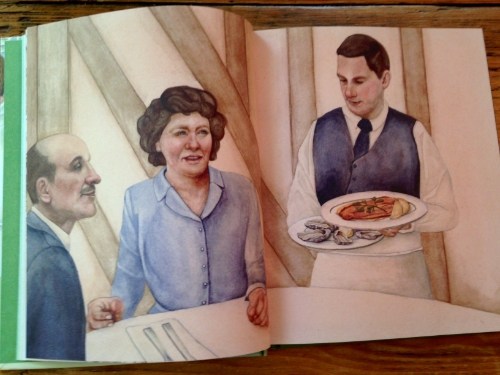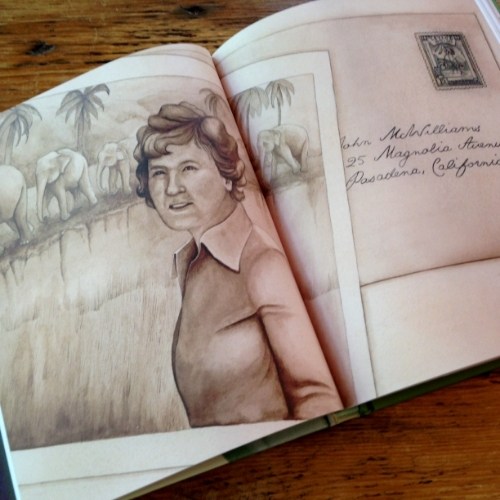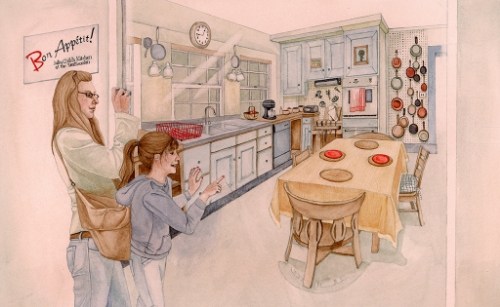
I’m doubly excited to welcome Baltimore-based author Erin Hagar to Alphabet Soup: her very first published children’s book hits shelves today, and it’s about one of my favorite people, Julia Child!
Though there have been several good picture books about Julia published in recent years, solidly researched middle grade biographies about her are few and far between. Not only is Julia Child: An Extraordinary Life in Words and Pictures (DuoPress, 2015) a lively, engaging read, it contains six beautiful full-page watercolor illustration sequences by Joanna Gorham interspersed between chapters.

Erin traces Julia’s life from her childhood as a fun-loving prankster in Pasadena to her death in 2004 as a much beloved cookbook author, teacher, and television celebrity. We read about how Julia met and fell in love with Paul Child while working overseas for the OSS (Office of Strategic Services), how when they moved to France Julia discovers her life’s passion and attends Le Cordon Bleu, how she started a cooking school and collaborated on Mastering the Art of French Cooking with Simone Beck Fischbacher and Louisette Bertholle, and finally, how she launched her television career on WGBH Boston.

Young readers will enjoy Julia’s larger-than-life personality, her boundless energy, her contagious joie de vivre. They will enjoy Gorham’s visual sequences that are like short cinematic glimpses of Julia’s major milestones. Erin has effectively culled the essence of Julia’s deliciously interesting, purposeful life, one that continues to inspire people of all ages, reassuring them that it’s never too late to pursue your dream.
I was curious to learn more about Erin’s research for the project as well as whether she had any tips for aspiring biographers. Lucky for us, Erin likes to cook and is also sharing one of her favorite recipes today. Bon Appétit!
* * *

🍴 AUTHOR CHAT WITH ERIN HAGAR 🍴
*
Why did you want to write a book about Julia Child for kids? Are you a longtime Julia fan?
Given how much I love and respect Julia Child now, it’s hard to believe how little I knew about her when I started. This book actually started with the structure. The publisher of Duopress had the great idea to adapt the visual format of Brian Selznick’s amazing The Invention of Hugo Cabret (Scholastic, 2007) to a biography, with several key moments in the subject’s life represented in visual sequences, to balance out the text. It’s an amazing concept. We brainstormed possible subjects, and I suggested Gordon Ramsay because my family loves Master Chef, Jr. After discussing it a bit, we thought, “Why not the television cook who started it all?” Voila–Julia it was!

The book begins with a note about the lunch that changed everything: the sole meunière Julia ate at the Hotel de la Couronne in Rouen, France, was the most exciting meal of her life. What do you consider to be the most exciting meal of your life so far?
I studied abroad in Spain when I was 19, and I was treated to lots of exciting meals there. Of course paella and jamón serrano (which hung in the family’s laundry room, with a few slices shaved off for special occasions) were incredible treats. But even the everyday dishes opened me up to new ways of eating. One of my favorites, that I tried my best to recreate when I got home, was a lentil stew filled with all kinds of vegetables and loaded with cumin. So rich and hearty and healthy!
Part of your research involved accessing The Julia Child Papers at the Schlesinger Library, Radcliffe Institute, Harvard University. What sort of materials proved to be the most helpful in writing your book?
This was my favorite part of writing this book. I could have lived in that little research room for weeks and weeks–and honestly, it would have taken that long to go through everything, because it’s an amazingly robust and well-curated collection! I loved seeing the letters that she and her friend Avis deVoto wrote each other, because they chronicle the ups and downs of writing Mastering the Art of French Cooking (among lots and lots of other things.) I also got to see her recipes, revised over and over again. Oh, and Julia’s handwritten notes on the typed-up scripts for her earliest TV shows. You really get a sense for how thorough she was in everything she did.

Please share a few tidbits about Julia the average person may not know.
- In general, she wasn’t in love with Italian or Mexican cuisine. And she HATED cilantro!
- She was a late bloomer–she didn’t figure out what she wanted to do with her life until she was in her late 30’s.
- She and her husband, Paul, met while serving overseas in the OSS (Office of Strategic Services, precursor to the CIA.) She wasn’t a spy herself, but provided administrative support to the spy operations in Ceylon (Sri Lanka) and China.
- Julia actually flunked her first exam at Le Cordon Bleu. The director of the school resented Julia and when it came time to give the exam, she chose recipes from this little beginner’s pamphlet–recipes far beneath Julia’s talents at that time. Julia didn’t have them memorized, so she flunked. (She took it again, though, and nailed it!)
- Everyone’s favorite anecdote about Julia–dropping a whole chicken on the floor during one of her shows and then picking it up and using it– never happened. She did knock over a bottle of brandy one episode, and in another she tries to flip a pan of potatoes and it spills on the stove, and she totally recovers with grace and humor from these moments. But she never dropped a chicken.

Please tell us about some of your favorite fan letters that Julia received from children. Do you think kids back then had as keen an interest in cooking as they do now?
Oh, those letters from kids! I think I might have squealed when I opened those. They were all handwritten in that wonderful kid handwriting. One girl talked about earning her cooking badge for Girl Scouts, and one boy asked about studying at Le Cordon Bleu. My favorite was from a 7th grade girl who told Julia that she’d been the only one in her Biology class to successfully dissect a crawfish because she cut it the way Julia had cut her lobster on TV the night before.

Kids are naturally scientific and creative, and cooking is both those things. So I do think there was a natural interest in cooking at that time, but not nearly as pronounced as it is today. Most adults in the 1960’s didn’t have the interest in cooking that we do today. That was one of Julia’s biggest challenges–here she was, writing a 700 page cookbook all about slow, deliberate French cooking when American food culture at the time was all about fast and easy, convenient and prepackaged. But it’s safe to say that the interest in food that Julia helped spark has lasted for generations, and she’s a big reason why today’s kids see so much cooking on television and have such a big interest in it themselves.
Are biographies your favorite genre to write? Do you have any tips for those wanting to write a biography for middle grade readers?
I write all over the place–fiction, non-fiction, picture books and novel-length works. There are lots of similarities. With fiction and biography, you’re trying to show the arc of a person’s experience, how she grows and changes, and the details of her life that affect those changes. The main difference with a biography, of course, is that you find those details in your research. As a fiction writer, I struggle with plot, so it was great to not have to come up with a reason why Julia moved to France. The reason was there.
One tip I’d suggest is to find as much as you can that your subject wrote or said, so you have something you can use as “dialogue” in the text. I was lucky with Julia–in addition to her autobiography, there are hundreds of interviews I could pull from, in addition to her television shows. Using direct quotes helps gives a sense of her voice, and helps the narrative to flow.
I’m working on another nonfiction book right now, and I’m struggling to find those quotes and primary sources. It’s made it more difficult to keep the text lively.


What do you hope young readers will take away from your book?
Somehow, our society has come to expect young children to have very specific talents, and to develop those talents from an early age. Of course, lots of kids do have talents and interests that are evident early in their lives, and that’s great. But many are still discovering what they love to do, and that’s okay, too! Julia is a wonderful example of someone who wasn’t sure what she wanted to do or be. She didn’t know until she was almost 40! And then she went on to become one of the very best.
Do you like to cook? How do you think Julia has influenced the way you eat and cook today?
I do like to cook, but with two busy kids and my writing I’m afraid I’m more like those moms in the 1960’s that Julia was working to change. I definitely look for “quick and easy” recipes, though I try to avoid processed and packaged. I’m a huge fan of one-pot meals.

Is there anything else you’d like us to know about your book?
The format of the book–the balance between text and image– is really exciting and fresh. The artwork done by Joanna Gorham is fantastic. You get such a sense of Julia’s spirit from the illustrations.

What’s next for you?
A new series tentatively titled, “Awesome Minds,” and the first one is “Awesome Minds: The Inventors of LEGO.” I’m really excited about it! It’ll be for a slightly younger set (7-10), a 48pp illustrated book.
Please share a favorite recipe (one of Julia’s or not) and tell us why you like making it.
Well, like I said, one-pot dinners are awesome on busy nights. I like this one because it hints of paella with basic pantry ingredients, and the capers and olives add a nice touch. It’s from the cookbook “Frugal Foodie,” by Alanna Kauffman and Alex Small.
Colombian Arroz con Pollo (Serves 6)
- 1 tablespoon olive oil
- 2 lbs. chicken breasts and thighs
- 1 medium green pepper, chopped
- 1 medium red pepper, chopped
- 1 medium onion, chopped
- 2 garlic cloves, minced
- pinch of saffron
- 1 teaspoon paprika
- 1 teaspoon cumin
- 1-1/2 cups rice
- 3 cups chicken broth
- 1/2 cup pimento olives, chopped
- 2 tablespoons capers
- 1/2 cup roasted red peppers, chopped
- 1 cup frozen peas
- salt and pepper to taste
In a deep pan (I use a Dutch oven), heat olive oil on medium high heat; brown chicken 4 minutes on each side. Remove and set aside. Add peppers, onions, and garlic to pan; cook until soft. Mix in saffron, paprika, cumin and rice; stir until rice is coated, about 1 minute. Add chicken broth; return chicken to pan. Cover tightly; simmer on medium heat 15-20 minutes, until most of broth is absorbed. Add olives, capers, roasted red peppers, peas, salt and pepper; stir and let cook 5 minutes uncovered. Serve hot.
* * *
🍵 SOUP OF THE DAY 🍵
Please join me now by dipping your spoons in today’s celebratory soup and slurping your hearty congratulations to Erin and Joanna. If you don’t have a spoon handy, feel free to dive right in and do a few backstrokes — I’m sure Julia wouldn’t mind. The furry Alphabet Soup kitchen helpers tossed in a few goldfish crackers, something Julia liked to serve dinner guests as an hors d’oeuvre.

* * *

JULIA CHILD: An Extraordinary Life in Words and Pictures
written by Erin Hagar
art by Joanna Gorham
published by DuoPress, May 2015
Biography for ages 9-12, 160 pp.
Cool themes: food, chefs, female role models, culinary history, cooking
**Includes Bibliography, Glossary, Timeline and Index
***A solid choice for school libraries!
♥ Click here for an English Language Arts Teaching Guide
♥ Baltimore area peeps, look for Erin at these upcoming book events:
- Saturday, May 16, SCBWI Booth at the Gaithersburg Book Festival, 2-4 p.m.
- Sunday, May 17, Kids’ Tent at the Art Outside Festival in Druid Hall Park, 11-12 p.m.
- Sunday, June 7, Julia release party for kids and adults at The Church of the Redeemer, 11:30 a.m. There will be cake!
* * *
![]() This post is being linked to Beth Fish Read’s Weekend Cooking, where all are invited to share their food-related posts. Put on your best bib and come join the fun!
This post is being linked to Beth Fish Read’s Weekend Cooking, where all are invited to share their food-related posts. Put on your best bib and come join the fun!
——————————————-
*Interior spreads posted by permission of the publisher, text and art copyright © 2015 DuoPress Books. All rights reserved.
Copyright © 2015 Jama Rattigan of Jama’s Alphabet Soup. All rights reserved.

This is AWESOME!!!!!!!! Thanks for sharing 😊😊😊😆😆😆😆
LikeLike
Glad you liked the post!
LikeLiked by 1 person
Love it!👍👍👍👍
LikeLike
Great interview. Thanks Jama and Erin! LOVE that lobster letter.
LikeLike
I know — love that letter too!
LikeLike
It looks as though they picked the perfect subject for their format! I especially like the illustration of Julia with all those chickens 🙂
LikeLike
It’s a unique and wonderful format. There’s just something about Julia and raw chickens :).
LikeLike
I *must* have this book!! I wasn’t aware of this one. Super interview — oh how I’d love to be in that research room with her notes and letters. And I LOVE that fan letter. How great is that? I bet Julia loved it too.
LikeLike
Yes, the Julia Child papers sound so amazing!! And I love that fan letter too.
LikeLike
Oh cool – a Julia book for kids! I loved her memoir My Life in France…and I read Julie & Julia as well 🙂
LikeLike
I’ve read My Life in France a couple of times — I love it too! It’s great that kids now have a quality biography to learn all about Julia.
LikeLike
I love this! Such a clever book and such a good way to get kids interested in Julia and her life. It is brilliant! Think I might have to get this for me. So, she hated cilantro. Well, that’s sad. I love cilantro. And no actual chicken dropped. You know, I always thought that sounded like an urban legend. LOL
LikeLike
I like cilantro too, though I hated it when I was a child. They say there’s a certain gene involved — for some people cilantro tastes awful, like soap.
LikeLike
This sounds fantastic! I have seen her kitchen at the Smithsonian but I’m not sure I’ve ever watched one of her shows. I do like her a bit more since she didn’t like cilantro!
LikeLike
Her shows are such a delight — Baking with Julia still airs on PBS and I think some of the very early French Chef shows are available on youtube.
LikeLike
What a neat book!
LikeLiked by 1 person
It is! Hope you get to see it soon. 🙂
LikeLike
I’ll be looking out for this one, Jama! Cheers from Carole’s Chatter!
LikeLike
Hope it’s available in your part of the world, Carole. 🙂
LikeLike
Julia and my husband have something in common- they both hate cilantro!
LikeLike
Like I said, you either love it or hate it. And it’s genetic!
LikeLike